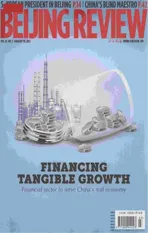Enhancing Comprehensive Economic Strength
2012-10-16本刊编辑部
Enhancing Comprehensive Economic Strength
In the past 30 years, successive Xiamen municipal and SEZ leaders have taken development as the top priority.Howeverthe international situation changed, they put economic construction as their key task. They have focused their efforts on accelerating economic and social development, improving the comprehensive competitiveness and economic strength of the city, and coordinating the development speed with structure, effectiveness and quality, thus enabling Xiamen to edge into the ranks of the top 10 powerful cities of the country.
In 2010, Xiamen, with its population accounting for 9.6 percent of Fujian Province and its land coverage taking up 1.3 percent of the provincial total, created 14 percent of the province’s total production output value,25.6 percent of the province’s gross fiscal income, and 52.4 percent of the province’s foreign trade value. Its status on the west bank of the Taiwan Straits has become more important.
Fast economic growth
In the past three decades, Xiamen’s economic strength has expanded with GDP soaring to 206.007 billion yuan ($31.45 billion) in 2010 from 741 million yuan($113.13 million) in 1981. Its GDP first exceeded 100 billion yuan ($15.27 billion)in 2005, and doubled in 2010—reaching 200 billion yuan ($30.53 billion). Its average annual growth rate in the past 30 years has hit 17.4 percent. Except for 1981, 1983,1985 and 2009, Xiamen has kept a doubledigit annual growth, which is among the fastest of its peers. Among nine cities under the administration of Fujian Province,Xiamen ranks first in annual growth rate,although its GDP ranks third after Fuzhou and Quanzhou. Among 15 sub-provincial cities across China, Xiamen ranks second only after Shenzhen in terms of the annual growth rate of GDP. The per-capita GDP of Xiamen in 2010 stood at 60,100 yuan($8,871), far exceeding the national and provincial average.
Promoting sustainable development
Xiamen lacks natural resources, thus it depends heavily on exports to support its resource needs. Since Xiamen was approved as an SEZ, it has held on to scienti fi c outlook on development, underlined the importance of economic development mode transformation, strived to reduce energy consumption, taken the lead in making a low-carbon city blueprint, strengthened supervision over key emission-reduction programs and major polluting sources,supported energy-conservation demonstration projects and the development of energy-saving technologies, and promoted energy-saving technologies and products.Xiamen has made remarkable progress in energy saving and emission reduction. In 2010, the energy consumption per 10,000 yuan ($1,526) of GDP stood at 0.569 tons of standard coal, which was equivalent to 54 percent of the nation’s average rate and 71 percent of Fujian Province’s average rate. The per-10,000 yuan ($1,526) industrial added value of the city consumed 0.408 tons of standard coal, which was equivalent to 36 percent of the average level of Fujian Province. Each square km of land created 131 million yuan ($20 million) worth of GDP and 240 million yuan ($36.64 million) worth of industrial output, which were 11 and 13.3 times that of the province’s average level and took the lead among large and medium-sized cities of the whole country. The sustainable development of Xiamen has spurred the coordinated development between economy, population, resources and the environment.
In 2010, the number of registered permanent residents in Xiamen was 1.8021 million, with a growth rate of 4.26 per thousand, down 1.414 percentage points from 1981. In 2010, about 97.5 percent of the days in Xiamen recorded relatively good air quality, while 42.7 percent of the days were cited as ones with good air quality. The sewage discharged and sulfur dioxide emission of major factories all reached the standard level. All medical and chemical wastes were processed in line with industrial standards. The emission of major pollutants—CO2and COD—totaled 45,000 tons and 46,700 tons respectively,showing a year-on-year decrease.
Better economic quality
Xiamen’s local fiscal strength has become stronger thanks to the ever-expanding economic scale, increased economic efficiency,and coordinated development of the economic scale, efficiency and speed. The total fiscal revenue of Xiamen rose to 52.602 billion yuan($8.03 billion) in 2010 from 195 million yuan($29.77 million) in 1981, increasing 280.6 times in 30 years with the annual growth rate hitting 21.5 percent. The fiscal revenue accounted for 25.5 percent of local GDP, higher than the average level of the country and Fujian Province, and topped the 15 sub-provincial level cities across the country and the nine cities under the administration of Fujian Province. At the same time of ensuring steady fiscal growth, Xiamen has actively adjusted and modified its fiscal expenditure structure so as to meet the capital needs in the fields of social security, science and technology,education, agriculture and rural development.In 2010, Xiamen’s fiscal expenditure stood at 30.695 billion yuan ($4.68 billion), which was 528.8 times that of 1981, with an annual growth of 24.2 percent. That year, the economic ef fi ciency comprehensive index of Xiamen’s large industrial enterprises reached 201.19, among which the total capital contribution rate was 13.92 percent, the capital maintenance and appreciation rate was 121.42 percent and the asset liability ratio was 53.2 percent, with their combined profits hitting 27.234 billion yuan ($4.16 billion). A total of 1,718 large industrial enterprises made pro fi ts in 2010.

COURTESY OF XIAMEN MUNICIPAL GOVERNMENT
